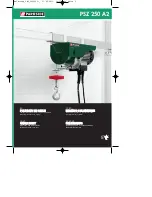
Page 8
3-1. General
This section presents information concerning the proper
operation on the Yale Electric Wire Rope Hoist. It is not intended
to serve as a handbook on rigging. Rigging, the process of
moving heavy loads using mechanical devices, requires special
knowledge and equipment. For information on the safe use of
slings and similar rigging gear, users are urged to consult a
textbook on rigging.
3-2. Safety Notes
a. Inspect the hoist for any sign of loose, broken, or
malfunctioning parts (see Section IV). Any malfunctioning
hoist should be tagged as "out of order" and removed from
service until the defect is corrected.
b. Before starting the hoist, the operator should be certain that
all personnel are clear.
c. Do not lift more than the rated load of the hoist.
d. Do not lift people or loads over people.
e. Avoid jogging controls or quick reversals of suspended loads.
f. Do not leave a suspended load unattended.
g. The operator should have a clear view of the load anytime
it is moving and should be sure that the load does not
contact any obstructions.
h. Read ANSI B30.16 Safety Standard for Overhead Hoists.
3-3. Handling The Load
a. Align hoist directly over load. Avoid side pull, since this can
cause the wire rope to jump grooves, or overwrap itself. This
condition will quickly damage the wire rope.
SECTION III - OPERATION
The overload limiting clutch is an emergency protection
device. It should not routinely be used to measure the
maximum load to be lifted.
CAUTION
b. The wire rope should not be wrapped around the load. Use
proper slings.
c. Be sure the wire rope is properly seated in the drum groove
and in the bottom block sheave.
d. Bring the hook into engagement with the load and make
sure it is well seated before proceeding to lift the load. Be
sure that the load is equalized on all supporting ropes.
e. Lift the load just clear of its supports and stop the hoist to
check for proper brake operation.
f. Avoid letting the hook or load swing excessively while moving
a trolley suspended hoist.
3-4. Overload Limiting Protection
This hoist is equipped with a factory-calibrated overload limiting
clutch, which permits lifting loads within rated capacity and
prevents lifting excessive loads which could damage the hoist.
If the load exceeds the lifting capability of the overload clutch,
the hoist will not lift the load, but the motor will run as long as
the "UP" button is pressed. Repeated attempts to lift an
excessive load will overheat the overload clutch and cause
permanent damage to the clutch.
For more information contact: Sievert Crane and Hoist, (708) 771-1600, parts@sievertelectric.com, www.sievertcrane.com






























